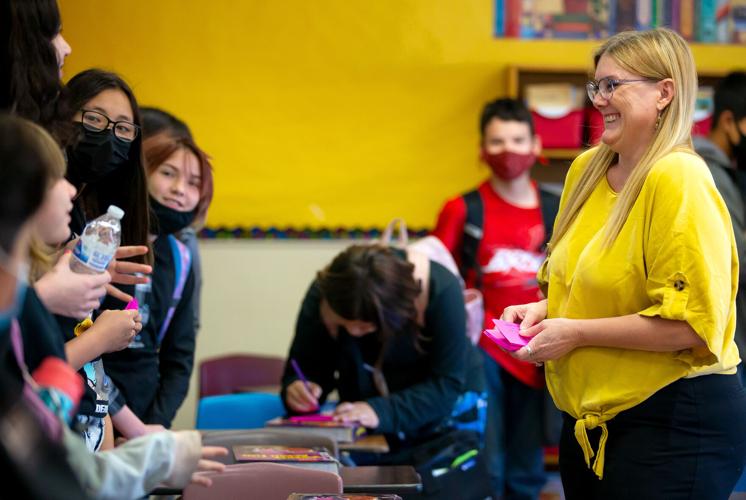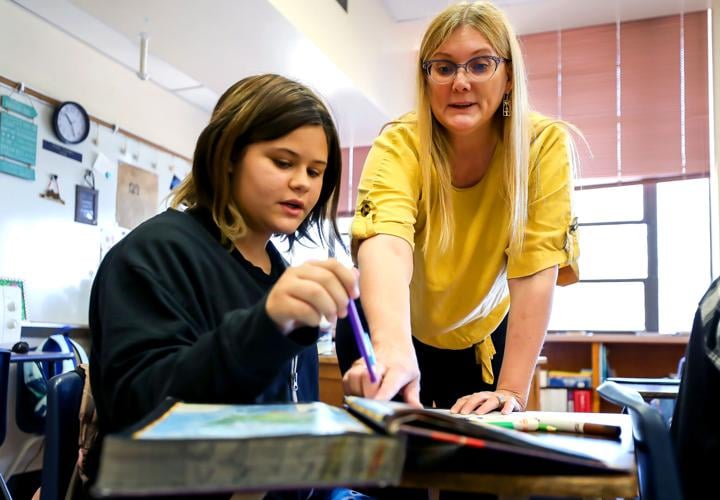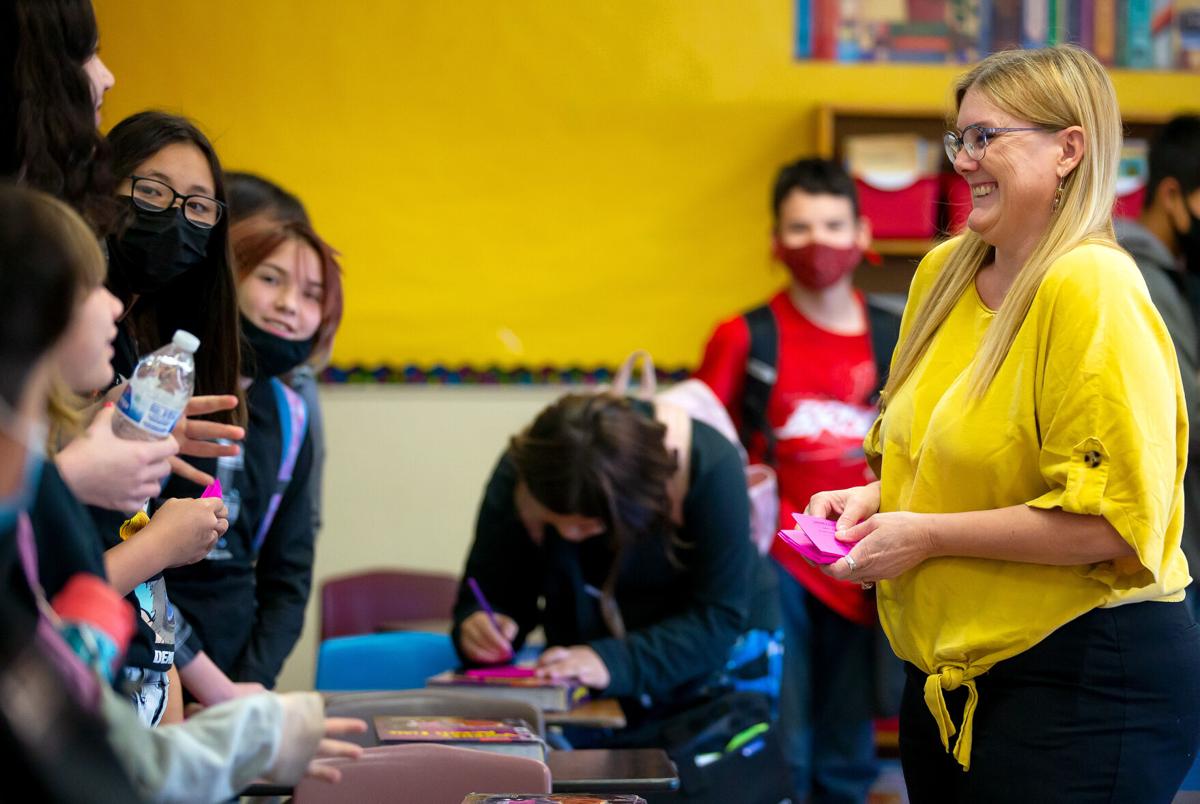The sixth grade students in Ms. Anna Timney’s second-period social studies class sat at their desks at Alice Vail Middle School earlier this month, their attention focused on the 10-minute video summarizing the day’s top news events.
Afterward, the students broke out to work individually or in groups on coloring a geographical map, each area a different color, to show that they understood the layout.
Timney said she chose a more laid-back activity than usual as she and the students began to wrap up a difficult academic cycle in which other teachers left the school midyear, shaking the daily routine for many students, marking a deeper dent in the school’s staffing numbers and putting a bigger workload on teachers like Timney.
When the only other sixth grade social studies teacher at Alice Vail went on leave last September, the students were left dealing with a rotation of different substitutes. So, Timney volunteered to take in those kids and combine them with her own classes.
“I did it because I felt it was what was right for the kids. They’ve already had two years of crazy schooling, definitely two years of trauma,” Timney, 50, said. “They needed some continuity and stability.”
With staffing shortages at schools throughout Arizona expected to continue into the foreseeable future, TUSD has been focusing its efforts on retaining its current staff and trying to attract new employees.
The district was unable to give a total amount of teacher vacancies expected for next school year, as it is still processing teacher hires and separations, said Leslie Lenhart, a TUSD spokeswoman.
In the meantime, teachers like Timney have been putting in the extra work to try to provide emotional stability for their students, while trying to keep classroom instruction from falling further behind grade-level expectations.
Timney noted that she initially believed the situation would be temporary until the end of December, but when the other teacher didn’t return to the school, Timney decided to extend her efforts for the rest of the school year.
“Another change would’ve been possibly a third or fourth teacher for them, or a series of substitutes,” Timney said. “That’s not fair to the students, and it’s certainly not fair for their education.”
Combining all those students meant Timney’s four classes each went from about 14 to 18 kids, initially, to double that amount in each class by mid-October. But Timney said that meant her work nearly quadrupled when it came to her in-person and on-paper responsibilities.

Teacher Anna Timney helps sixth grader Buggs Baker with an assignment during social studies class at Alice Vail Middle School.
‘Not the only one’
On May 10, Timney spoke during a call to the audience at the Tucson Unified School District governing board meeting to ask for proper compensation for the additional responsibilities that she and other teachers have taken on this school year in response to the staffing shortages.
She asked the board to note that the district had provided additional compensation for her throughout the second quarter of the school year, when she initially combined all the sixth grade social studies classes.
But when she returned to the school after Winter Break, the district had pulled that additional compensation for her added responsibilities.
“I’m not the only one in my school doing this. There’s other teachers in the school taking on other classes, combining classes,” she said. “It’s added more time that we’re spending away from our families because we’re trying to do our job, and what’s best for the kids.”
Principal Tamara Nicolosi said that there were a total of three teachers at Alice Vail Middle School who had permanently taken on combined classes for the duration of the academic cycle after other teachers left midyear.
“Our teachers are phenomenal here,” Nicolosi said. “Teachers have really gone above and beyond anything you could ever imagine to make sure students are taken care of, not just academically, but socially and emotionally, as well.”
There was a trend of teachers taking on combined classes throughout the district this year, said Margaret Chaney, president of the Tucson Education Association.
Chaney said the main solutions that the district could focus on are hiring more teachers and retaining the ones they already have — an effort TUSD has been working on by raising salaries and offering retention stipends.
However, she added that the issue is much bigger than something that TUSD could address alone. Teachers throughout Arizona, she said, have been discouraged by statewide politics concerning education.
When asked how TUSD planned to address the added pressure on its teachers, Lenhart, the TUSD spokeswoman, said that the district had hired more than 200 substitute teachers this year and had created positions for permanent subs that work regionally to cover classrooms.
But, as it was in Timney’s experience this year, substitute teachers don’t always stick around for the time that is needed in each classroom, particularly at the middle school level.
“It’s nothing against substitutes, it’s just an awkward group of kids to work with,” Timney said. “It takes a special kind of person to work with them because they’re not little kids anymore, but they’re also not adults.”

Anna Timney, a sixth grade social studies teacher, talks to her class at Alice Vail Middle School.
Adjusting and keeping up
Not only did the new changes take time to adjust for Timney, but it also took some readjusting among the two student groups.
Timney said she took her original students’ reactions as a bit disappointed that there would be major changes to the class. But the other teacher’s students, who had already been through a heavy rotation of substitutes in the first quarter of the school year, were much more excited and positive about having stability in their daily routines.
She said the first few months were the most challenging because it was a time of learning the new classroom dynamics and getting to know each kid individually, such as which students were the trouble-makers, the studious ones and the class clowns.
One of her biggest concerns, she said, was ensuring that she provided each student with enough individual attention to help them address their personal and academic struggles.
“You don’t realize how much trauma there was for the last two years until you simply talk to these kids,” Timney said. “This is the year where they’ve been processing it, getting to know their teachers and starting to trust people again.”
She worried that the bigger class sizes would interfere with her ability to provide students with the necessary resources.
But at least one of Timney’s students, 12-year-old Buggs Baker, confirmed that they received all the help they needed from their teacher.
Baker noted that Timney’s class was sometimes louder and more chaotic than their other classes, given the amount of students in the room. But that didn’t mean that the attention they received was any less.
“Honestly, I’m really impressed by how she somehow manages to keep everyone on track and individually help them while the classes are really big,” Baker said. “Ms. Timney is amazing, literally. She’s really kind and helps out a lot — even when she has a lot of stuff to do and grade, she still tries to help out everyone.”
And as she wrapped up the second-to-last week of the school year this month, Timney reflected on the close relationships that she had been able to build with the whole sixth-grade class due to this experience.
“In that regard, it’s been really cool because I’ve gotten these relationships with kids that I would not have otherwise had a relationship with,” she said. “We’ve seen some amazing growth, seen kids come out of their shells, and I know that some of them will invite me to their high school graduations.”







